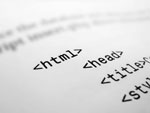 The World Web Web Consortium has published guidelines to help designers make their sites more accessible. ContentRobot has summarized some key points below.
The World Web Web Consortium has published guidelines to help designers make their sites more accessible. ContentRobot has summarized some key points below.
- Make multimedia content (images, video, and audio) more accessible to a wide audience. This can be done using text equivalents (often rendered with Alt tags within HTML documents). Text can be rendered in ways that are available to almost all browsing devices and accessible to almost all users.
- Provide non-text equivalents (e.g., pictures, videos, and pre-recorded audio) for text to offer visual cues that convey the same information. This can be beneficial non-readers or people who have difficulty reading.
- Ensure that text and graphics are understandable when viewed without color. Some people cannot differentiate between certain colors and users with devices that have non-color or non-visual displays will not receive the information.
- Separate structure from presentation and content by ensuring that HTML and CSS markup is coded properly. Mark up documents with the proper structural elements and control presentation with style sheets rather than with presentation elements and attributes. Misusing markup for a presentation effect (e.g., using a table for layout or a header to change the font size) makes it difficult for some users to understand the organization of the page or navigate through it.
- Ensure that pages are accessible even when newer technologies (using Flash or Javascript, for example) are not supported or are turned off. Some users still work with older browsers and some choose to turn off newer features. Finally, if the interface of the embedded object cannot be made accessible, an alternative accessible solution must be provided.
- Create documents that do not rely on one type of hardware. Pages should be usable by people without mice, with small screens, low resolution screens, black and white screens, no screens, with only voice or text output, etc.
- Provide a clear and consistent navigation, including orientation information, navigation bars, a site map, etc. This increases the likelihood that a person of any ability will find what they are looking for at a site.
- Provide a consistent page layout, recognizable graphics, and easy-to-understand language benefits all users as it promotes effective communication.
In sum
There are a variety of simple guidelines that designers, developers, and content providers can do to make their blog pages more accessible to persons of all abilities. We’ll even delve deeper with more accessibility tips in our next post.
Related Posts: Is Your Blog Accessible to People With Disabilities? and Tips & Tricks to Improve Blog Accessibility
